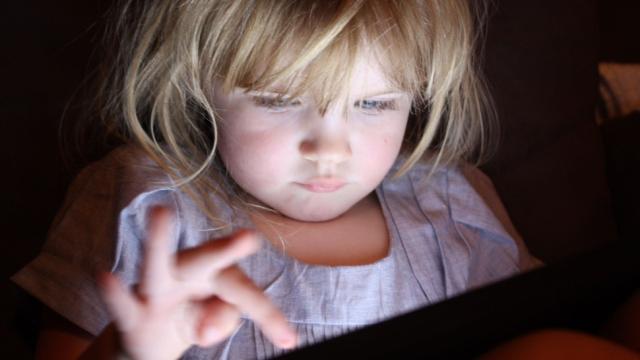Touchscreen devices like smartphones and tablets are now fixtures of many households, so it comes as little surprise to learn that young children who don’t work or go to school are among their most active users. In the first study of its kind, researchers have learned that infants and toddlers who spend more time on these devices sleep less at night. It’s a troubling finding, but the reasons for these sleep disruptions are still unclear.
Traditional screen time, like television and video games, has been linked to sleep problems in children, but less is known about portable touchscreens, such as smartphones and tablets. In the first study to investigate potential links between touchscreens and sleep in young children, a research team led by Tim Smith from Birkbeck University of London has found that the same sleep disruption effect applies to these modern devices. By surveying parents about their kids’ touchscreen use and sleep patterns, these researchers have found that every additional hour of tablet or smartphone use among children between the ages of six months and three years results in about 15 minutes less total sleep. These findings now appear in Scientific Advances.
From June 2015 to March 2016, the parents of 715 infants and toddlers aged six months to 36 months (3 years) participated in the online survey. Roughly 70 per cent of the parents surveyed owned a touchscreen device of some kind. In these households, 75 per cent of young children used a touchscreen on a daily basis. Amongst children who had daily access to touchscreens, 51 per cent were between the ages of six to 11 months, and 92 per cent were between 25 to 36 months.
Parents were asked to report on the average duration of their child’s daytime and nighttime sleep, the time it typically takes for their child to fall asleep, and the frequency of their night awakenings. When parsing the results, the researchers controlled for age, sex, TV exposure, and maternal education.
According to their findings, babies and toddlers who spent more time with a touchscreen device slept less at night. Some of these kids managed to nap a bit longer during the day, but they still slept for less time overall. On average, each hour that a child spent on a smartphone or tablet resulted in 26 minutes less nighttime sleep, and about 10 minutes more daytime sleep, amounting to 15.6 minutes less total sleep. Touchscreen use was also linked to an increase in the time it took these kids to fall asleep, but there appeared to be no effect on the number of times these kids woke up at night.
“These results indicate that the popularity and accessibility of touchscreen devices has led to high levels of usage by babies and toddlers, and this is associated with reduced sleep,” noted Smith in a release. “Future research is now needed to build on this initial study to try and understand whether touchscreen use is causing sleep problems and how types of use may mitigate these risks.” Looking ahead, the researchers would like to understand the mechanics behind this link, and to develop more objective measures of sleep. Online surveys are just a start — what’s required now are empirical sleep tracking studies to confirm the parent-reported findings.
Michael Gradisar, a psychologist at Flinders University who wasn’t involved with the study, says this research raises awareness of the fact that babies are using technological devices, but does little to explain the reasons behind the reported correlations.
“This was a survey of infants’ and toddlers’ touchscreen use and sleep, and so the type of protocol used does not tell us if touchscreen use causes poor sleep, or whether children with poor sleep are more likely to be given touch screen devices from their parents — for example, to distract them or settle them down,” Gradisar told Gizmodo. “There are also other factors that can affect a young child’s sleep — such as napping, evening stimulation (noise, artificial lighting) — that were not considered in the study’s prediction of infants’ nighttime sleep. If they were, the contribution of touch screen use to nighttime sleep might be less than anticipated.”
